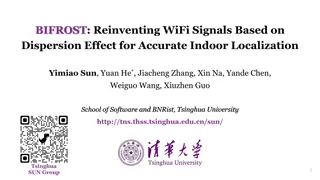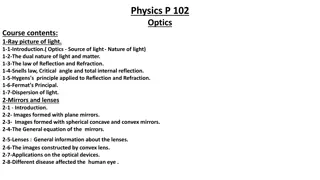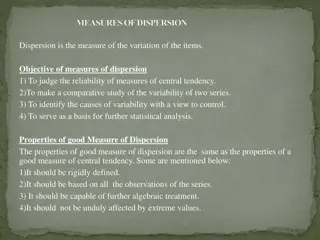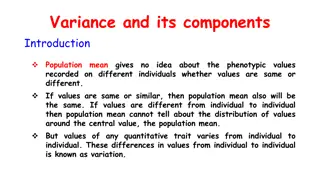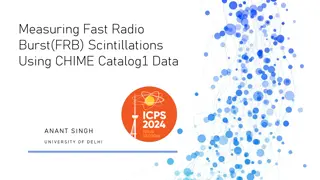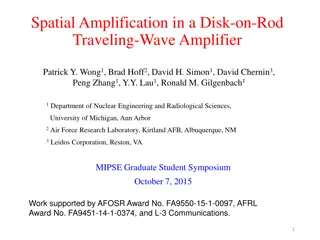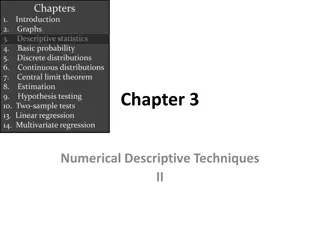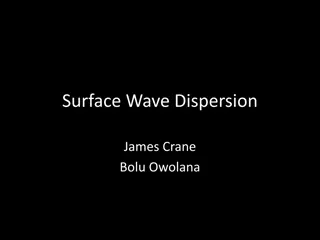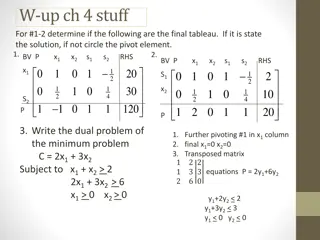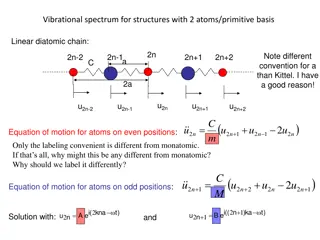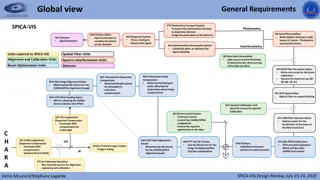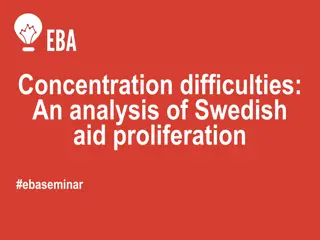Reinventing WiFi Signals for Accurate Indoor Localization with BIFROST
This research by the Tsinghua SUN Group introduces BIFROST, a novel approach that reinvents WiFi signals based on dispersion effect to enable precise indoor localization. The study addresses the challenge of limited line-of-sight (LoS) access points in indoor environments through Frequency and Spati
3 views • 26 slides
Exploring Optics: Light Behavior and Properties
Optics studies the behavior of light, its interaction with matter, and the construction of instruments using or detecting light. From the dual nature of light to the laws of reflection and refraction, this branch of physics delves into topics like mirrors, lenses, and the dispersion of light. Practi
2 views • 15 slides
Recycle Right: Strategies and Practices in Recycling Campaigns and Information Dissemination
Delve into the world of recycling campaigns and information dissemination with insights from Jessica Dalzell, an Environmental Specialist II in the Recycling and Sustainability Unit. Explore survey results on Recycle Right initiatives, coordination with haulers/processors, methods of information dis
0 views • 17 slides
Understanding Descriptive Statistics in Research
Descriptive statistics are essential in summarizing and analyzing large datasets to uncover trends and tendencies within the data. They include measures of central tendency, dispersion, and skewness, aiding in better understanding and communicating research results. Frequency distributions provide i
0 views • 32 slides
Earth-GRAM Overview and Updates 2023
Earth-GRAM is a global reference atmospheric model providing monthly mean and standard deviation data for various atmospheric variables. It is used in engineering for dispersion simulations but is not a forecasting model. Updates to Earth-GRAM include the Modern Era Retrospective Analysis, a global
0 views • 19 slides
Understanding Basic Meteorology Concepts for Air Quality Management
Pollutants circulate in the troposphere following air movement patterns around low-pressure fronts and high-pressure systems. Anticyclones and cyclones play a crucial role in atmospheric stability and pollutant dispersion. The relationship between lapse rates determines air stability and pollutant d
0 views • 24 slides
Understanding Inhibited Mud Systems in Drilling Operations
Inhibited mud systems play a vital role in drilling operations by repressing clay hydration and dispersion, offering advantages like higher clay concentration tolerance, reduced effects of contaminants, and better control of mud weight and viscosity. These systems are categorized into different type
0 views • 36 slides
Understanding Populations: Factors Affecting Growth and Dynamics
In the study of populations, factors like carrying capacity, density-dependent, and density-independent growth play crucial roles. Learn about estimating population size, dispersion patterns, growth rates, and more to understand how populations change over time.
0 views • 25 slides
Gas-Liquid Equipment in Mass Transfer Operations
Gas-liquid operations play a crucial role in mass transfer processes by facilitating intimate contact between the two fluids for efficient interphase diffusion. Various equipment such as sparged vessels (bubble columns) and mechanically agitated vessels are used to disperse gas or liquid phases, pro
2 views • 27 slides
Understanding Measures of Dispersion in Statistics
Measures of dispersion in statistics help in understanding the variability of data points. They are essential for assessing the reliability of central tendency measures, comparing data sets, identifying variability causes, and guiding further statistical analysis. The properties of a good measure of
0 views • 8 slides
Understanding Colloidal Dispersions and Classification
In the realm of dispersed systems, molecular, colloidal, and coarse dispersions differ in size rather than composition. Colloidal dispersions consist of particles ranging from 1 nm to 1 micrometer, exhibiting unique characteristics and examples. The classification is also based on physical states an
1 views • 127 slides
Understanding Colloids and Their Importance in Pharmaceuticals
Colloids play a vital role in the pharmaceutical industry as heterogeneous biphasic systems with particle sizes ranging from 1nm to 100nm. They are classified based on aggregation and interaction of phases, with examples like aerosols, foams, emulsions, and more. Colloids can be prepared by condensa
0 views • 23 slides
Understanding Pharmaceutical Suspensions
A pharmaceutical suspension is a dispersion of finely divided insoluble material in a liquid medium, available in liquid or dry form. These suspensions are essential for unstable drugs and come in different particle sizes, from colloidal to coarse. The particles in a suspension vary in size, influen
1 views • 88 slides
Understanding Light and Lenses: Exploring Colors and Images Formed
Explore the fascinating world of light and lenses in this module. Discover how lenses work, types of lenses like convex and concave, images formed by lenses, and the dispersion of sunlight into seven colors. Engage in activities showcasing the colors of sunlight and delve into the enchanting realm o
1 views • 10 slides
Optical Properties of Optically Active Compounds
Circular dichroism and optical rotatory dispersion are important techniques for studying the optical properties of optically active compounds. Circular dichroism measures the differential absorption of left and right circularly polarized light components, while optical rotatory dispersion studies th
0 views • 17 slides
Understanding Statistics: An Overview of Business Statistics in MSMSR
Learn about the core concepts of statistics in business through this MSMSR lecture plan module covering topics such as the introduction to statistics, definition of statistics, functions, scope, limitations of data, classification of data, and tabulation of data. Discover how statistics plays a cruc
1 views • 37 slides
Understanding Variance and Its Components in Population Studies
Variance and its components play a crucial role in analyzing the distribution of quantitative traits in populations. By measuring the degree of variation through statistical methods like Measures of Dispersion, researchers can gain insights into the scatterness of values around the mean. Partitionin
1 views • 22 slides
Understanding Measurement Uncertainty in Testing: Essentials and Guidelines
Measurement uncertainty in testing is a crucial aspect that characterizes the dispersion of values attributed to a measurand. This uncertainty plays a key role in reporting accurate test results, requiring careful evaluation of all significant contributions. The ISO/IEC Guide 98 GUM provides essenti
1 views • 18 slides
Oregon Health Authority Measure 110 Grant Proposals Webinar Overview
Oregon Health Authority (OHA) hosted a webinar on Measure 110, focusing on Behavioral Health Resource Networks (BHRNs) and grant proposals. The webinar featured introductions to OHA staff, details about Measure 110, BHRN structure, Q&A session, and contact information for grant-related queries. Meas
0 views • 39 slides
Understanding Van der Waals Forces and Intermolecular Interactions
Van der Waals forces encompass London dispersion forces, dipole-dipole forces, and hydrogen bonding, influencing interactions between atoms and molecules. London dispersion forces are the weakest and present in all molecules, dipole-dipole forces involve permanent dipoles, and hydrogen bonding, the
0 views • 9 slides
City of Atascadero Sales Tax Measure Consideration by City Council
City of Atascadero is considering placing a one-cent sales tax override measure on the November ballot to address financial challenges and maintain essential services. The proposed measure aims to generate funds for public safety, park maintenance, infrastructure, graffiti removal, and other city se
0 views • 15 slides
Introduction to Spectroscopic Instrumentation and Monochromators
Today's lecture covers spectroscopic instrumentation with a focus on monochromators. It delves into the components and performance measures of spectrometers, including wavelength discrimination filters, light detectors, and energy dispersive detectors. The dispersion of light through prisms and grat
0 views • 17 slides
Radiological Dispersion Device Tabletop Exercise Overview
This tabletop exercise focuses on simulating a radiological dispersion device scenario to enhance emergency response readiness and assess response plans. The exercise includes agenda discussions, administrative details review, scenario analysis, facilitated discussions, action planning sessions, and
0 views • 32 slides
Exploring Fast Radio Bursts (FRBs) and Scintillations in the Universe
Fast Radio Bursts (FRBs) are millisecond-duration bursts of radio waves originating from outside our galaxy, offering researchers a unique opportunity to investigate baryon distributions and probe the cold gas clumps in the Universe. Scintillations in radio waves caused by irregularities in the inte
1 views • 25 slides
Spatial Amplification in Disk-on-Rod Traveling-Wave Amplifier Study
Explore the viability of Disk-on-Rod Traveling Wave Tube (TWT) for high-power microwave devices with wide bandwidth. Analyze the spatial amplification rate through hot-tube dispersion relations, comparing against Particle-in-Cell code simulations. Schematic diagrams and cold-tube dispersion relation
0 views • 13 slides
Understanding Descriptive Statistics in Data Analysis
Descriptive statistics provide a vital framework for analyzing data by focusing on three key characteristics: measures of center, dispersion, and shape. Standard deviation, a fundamental measure, helps assess variability in distributions through the Empirical Rule and Chebyshev's Theorem. These prin
0 views • 27 slides
Understanding Intermolecular Forces: Strength, Types, and Examples
Intermolecular forces are attractions between molecules, weaker than chemical bonds. They include London dispersion forces, dipole-dipole interactions, and hydrogen bonding. Strength varies, with covalent bonds being the strongest and London dispersion forces the weakest. Different types of intermol
0 views • 15 slides
City of Oakland Finance Dept. Public Outreach Session - Measure W Vacant Property Tax Implementation Ordinance
The City of Oakland Finance Department conducted a public outreach session on the implementation of Measure W, a vacant property tax ordinance. The session aimed to receive public input, provide an overview of the tax and exemptions, and outline the implementation process. Measure W, approved by cit
0 views • 11 slides
Understanding Surface Wave Dispersion in Seismic Exploration
Surface wave dispersion, explored by James Crane and Bolu Owolana, plays a crucial role in seismic studies. This phenomenon, involving waves spreading at varying speeds, helps evaluate subsurface characteristics based on wavelength. By studying surface waves, researchers can determine velocity, dens
0 views • 14 slides
Overview of Measure T Project and Program in 2022
This content provides an overview of the Measure T Project and Program in 2022, showcasing details such as revenues, maintenance of effort, project specifics including street segments, sidewalk lengths, and curb ramps installed or replaced. Images are included for various project locations like Blan
0 views • 14 slides
Understanding Intermolecular Forces and Dispersion Forces in Molecules
Particle diagrams of liquids, solids, and gases reflect distinct arrangements due to intermolecular forces. The existence of substances as gases, liquids, or solids at room temperature is attributed to the forces between molecules known as intermolecular forces (IMF), with dispersion forces being th
0 views • 30 slides
Statistics: Understanding Variance and Standard Deviation
Understand the concepts of population variance, sample variance, and standard deviation. Learn how to calculate these measures for sample and grouped data, and their significance in analyzing data dispersion. Discover the differences between population and sample variance, and when to use each measu
0 views • 11 slides
Investigating Ship Wakes and Wave Patterns
Explore the visual similarities between ship wakes and Mach cones, considering various parameters such as boat velocity and length. Delve into wave equations, dispersion effects, and experimental results while addressing questions on water speed, wake formation, and wave models. Analyze the correlat
0 views • 8 slides
Understanding Sediment Dispersion along the Continental Margin
This content explores the influences and types of sediment dispersion systems along the continental margin. Processes affecting sediment supply, depositional environments, and different dispersal systems like Estuarine Accumulations Dominated and Marine Dispersal Dominated are discussed. Walsh and N
0 views • 8 slides
Vibrational Spectrum in Diatomic Chain Structures: Analysis and Eigenmodes
The vibrational spectrum of structures with two atoms in a linear diatomic chain is examined, focusing on the equation of motion for atoms at even and odd positions, phonon dispersion, transverse acoustic and optical modes, longitudinal eigenmodes in 1D, and extending the 1D model to 3D for phonon d
0 views • 20 slides
Understanding NOAA's HYSPLIT Model for Predicting Volcanic Ash Dispersion
NOAA's HYSPLIT model is crucial for predicting the transport and dispersion of volcanic ash. By utilizing satellite data, this model aids in issuing advisories for aviation safety. Applications of the model extend to various atmospheric tracer studies. Inverse modeling techniques are employed to est
0 views • 14 slides
Understanding Bandwidth and Dispersion in Fiber Optic Communication
This presentation provides a comprehensive overview of bandwidth and dispersion in fiber optic communication. It covers essential terminologies like microns, nanometers, millimeters, and dB, explaining concepts such as bandwidth capacity, dispersion cancellation, and modal bandwidth in multimode fib
0 views • 24 slides
Dynamic Aperture Optimization for CEPC Main Ring
Lattice design and dynamic aperture optimization for the Circular Electron Positron Collider (CEPC) main ring were discussed, focusing on maximizing the dynamic aperture through lattice configurations in the ARC region, interaction region, and partial double ring region. Various strategies such as c
0 views • 14 slides
SPICA-VIS Photometry Transport System Overview
This detailed overview outlines the intricate components of the SPICA-VIS photometry transport system, including modules for photometry, interferometry, dispersion, signal detection, and more. Key elements such as the optical fiber feeding optics, polarization delay compensator, atmospheric dispersi
0 views • 21 slides
Understanding Swedish Aid Proliferation: Challenges and Solutions
Delve into the complexities of aid dispersion in Sweden, analyzing the impact on efficiency and growth. Get insights on measuring aid dispersion, coordination vs. cooperation, and strategies to reduce costs. Explore why aid dispersion is a problem, the importance of concentration, and the need for e
0 views • 36 slides
